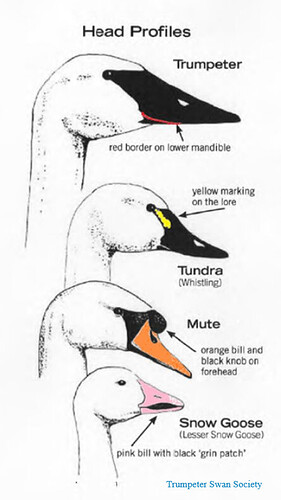Hello,
Could anyone tell me for sure the difference in coloring? I believe that the body and neck of a Mute swan is white but the Trumpeter has some brown coloring?
M
Both species are basically all white in colour as adults, and can show varying degrees of brown/grey as juveniles.
Mute Swans have orange bills with a bit of a knob at the top while Trumpeters have all black bills as adults.
Mute Swans, in particular in North America tend to be shall we say big-bottomed as well, they look chunkier in particular in the rear.
Depending on where you are located and the time of year, you may also encounter Tundra Swans, which also have all black bills, but have a flash of yellow in front of their eyes (called lores in birding parlance).
A couple of notes here – first, a few Tundra Swans will lack the yellow on the bill, so if you’ve got a group with black bills, look at all of them. Tundra Swans are noticeably smaller than the other two, so if you get one with an all-black bill in the middle of a bunch of obvious Tundras, and it’s the same size, then it’s most likely a Tundra.
Second, many Trumpeters do end up with rusty staining on their head and neck, which we don’t often see with the others, but that’s environmental and will vary with where the bird’s been feeding since it last molted.
Thank you! This helps a lot. I wanted to make sure I was talking about the correct swan!
M
Thank you. The last two I observed had the coloring on the neck. They are in a smaller city in a lake. The bottom gradually falls down and the bottom has not been found (as of yet). I am pretty the diet is normal. Not sure if those things make a difference
M
Welcome to the Forum, Michelle. Your post took me off on an interesting tangent. (I often seem to swing off on tangents, lately - sorry).
That was an interesting description of the lake! I looked at your swan observations around Lake Anna. The lake almost a circle! I wondered if it was man made and how such a small lake could be so deep.
I learned that it is a kettle lake - formed when a big piece of glacier calved off a retreating glacier. What an interesting landform!
This topic was automatically closed 60 days after the last reply. New replies are no longer allowed.

